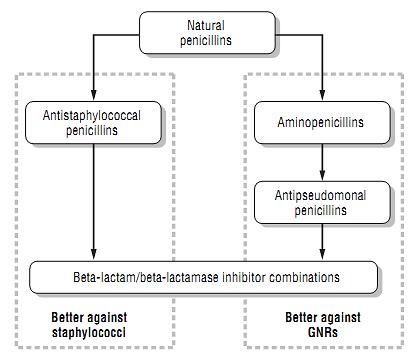


 النبات
النبات
 الحيوان
الحيوان
 الأحياء المجهرية
الأحياء المجهرية
 علم الأمراض
علم الأمراض
 التقانة الإحيائية
التقانة الإحيائية
 التقنية الحيوية المكروبية
التقنية الحيوية المكروبية
 التقنية الحياتية النانوية
التقنية الحياتية النانوية
 علم الأجنة
علم الأجنة
 الأحياء الجزيئي
الأحياء الجزيئي
 علم وظائف الأعضاء
علم وظائف الأعضاء
 الغدد
الغدد
 المضادات الحيوية
المضادات الحيوية|
Read More
Date: 30-3-2016
Date: 30-3-2016
Date: 30-3-2016
|
Penicillins
Penicillins are one of the largest and oldest classes of antimicrobial agents. Since the development of the natural penicillins in the 1930s, further penicillin development has been directed by the need to combat increasing antimicrobial resistance. Classes of penicillins with expanded Gram-negative spectra overcome the shortfalls of natural penicillins, and they can be grouped fairly easily by spectrum of activity.
Penicillins have several things in common:
• Penicillins have very short half-lives (˂ 2 hours) and must be dosed multiple times per day. The half-lives of most of them are pro-longed in the presence of renal dysfunction.
• Like other beta-lactams, penicillins can cause hypersensitivity reactions. If a patient has a true hypersensitivity reaction to a penicillin, other penicillins should be avoided, even if they are from different subclasses of penicillins. If the reaction is not severe, cephalosporins or carbapenems may be useful.
• Many penicillins are relatively poorly absorbed, even those available as oral formulations. This can lead to diarrhea when oral therapy is needed. Pay attention to the dosing of oral versus intravenous (IV) penicillins—often, a con-version from IV to oral therapy means there will be a substantial decrease in the amount of active drug in the body.
Many penicillins were developed after the natural penicillins became available. Until re-searchers developed beta-lactamase inhibitors, development primarily focused on either improved activity against staphylococci (MSSA) or GNRs (Figure 1).

Figure 1: Penicillin Drug Development
References
Gallagher ,J.C. and MacDougall ,c. (2012). Antibiotics Simplified. Second Edition. Jones & Bartlett Learning, LLC.



|
|
|
|
تفوقت في الاختبار على الجميع.. فاكهة "خارقة" في عالم التغذية
|
|
|
|
|
|
|
أمين عام أوبك: النفط الخام والغاز الطبيعي "هبة من الله"
|
|
|
|
|
|
|
المجمع العلمي ينظّم ندوة حوارية حول مفهوم العولمة الرقمية في بابل
|
|
|